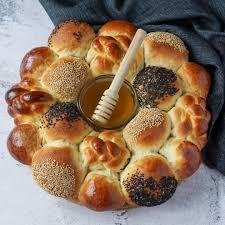The Challah
15: 17-21
The Challah DIG: How often was it made? What is the importance of setting aside the challah? How is this a teaching symbol? Why do you think ADONAI made this mitzvot?
REFLECT: How is this mitzvah observed today? How does it serve the same purpose as it did for the ancient Hebrews? What is the difference between then and now?
We are not to forget ADONAI in our daily lives, and not to leave our first love.
Bread is a staple. It was, and is, the most common everyday food. In ancient times it was made new each day. The Torah taught that when (not if) they entered the Land (15:17-18a), they were subject to the mitzvah of the challah (a loaf). It is interesting to note that these instructions were only applicable when they entered the Land. Which shows that despite the sin of Kadesh-barnea (to see link click Bz – Faith and Obedience), despite the fact that the Exodus generation would not enter the Promised Land, the covenant of the Land is still valid. Ownership of the Promised Land is unconditional (see the commentary on Genesis Eg – I AM the LORD, Who Brought You Out of Ur of the Chaldeans to Give You This Land); however, enjoyment of the Land is conditional. ADONAI’s Covenant with Moshe (Exodus 19:3-25) is a conditional divine pledge to be Isra’el’s God, protector, the advocate and sustainer of her blessed destiny; the condition was Isra’el’s dedication to Ha’Shem as symbolized by observing the 365 prohibitions and 248 commandments in the Torah (see the commentary on Exodus Dd – The Mosaic Covenant).274

When you enter the Land where I am bringing you and eat bread produced in the Land, you are to set aside one loaf as an offering for ADONAI. It was to be the first loaf to be made from the batch of dough, a kind of first-fruits offering. When they did this, the Israelites would take the time daily to acknowledge who their source of life was, and how much YHVH had provided. Not only that, by giving the challah to the LORD (the priesthood), it reminded them to constantly give their best and first to Him. Present a portion from your first (Hebrew: resheet, meaning the first part of the crop) dough that you are baking as a cake offering; set it aside as you would set aside a portion of the grain from the threshing-floor (15:18b-20). In terms of holiness, it was to be treated as an offering of the threshing-floor. This meant that it was dedicated to the priesthood and their families and could only be eaten in a state of ritual purity (see the commentary on Leviticus Bj – The Mitzvot of Purification).
The Torah does not prescribe how large the portion of challah removed from the batch of bread should be. Like the edges of the fields for gleaning (see Ruth Aq – Ruth Gleans in the Field of Bo’az), the measure is left unspecified. The rabbis, however, determined minimums. They have said that a batch of dough must be at least an omer of flour (about three quarts) to be subject to the mitzvah challah. The size of the portion must be at least 1/24th of the total batch. A baker is allowed to make it only 1/48th of a total batch. In the Torah, the mitzvah is specifically limited to bread made in the land of Isra’el. The Sages further limited it to dough made from the flour of five grains produced in the Land: wheat, spelt, barley, rye, and oats. However, rabbinic halakhah (mitzvot governing Jewish life) broadened the mitzvah to apply to all lands in every age least the principle be forgotten.275 Throughout the generations to come you are to give this offering to ADONAI from the portion from your first dough to support the priesthood (15:21). After the fall of the Second Temple this custom was still maintained: pious Jews would throw a handful of the dough into the fire as a sort of a mini-sacrifice, thereby making every fireplace an altar and every kitchen a house of God.276
The same mitzvah is observed today with a slight variation. Messianic believers do not give a portion to the priesthood because it is nonexistent today. Instead, we call the special braided bread on the evening of the Sabbath, challah. We say the special blessing seen below and acknowledge, in a special way, that He is the only source of life and sustenance. Practicing the Torah of the challah helps us to constantly remember our Lord and Provider.277
Barukh attah ADONAI Eloheinu melekh ha’olam,
ha’motzi lechem min ha’aretz.
Blessed are You, LORD our God, King of the universe,
Who brings forth bread from the earth.



Leave A Comment